Sponges (phylum Porifera) are very simple multicellular animals with no true tissue and organ (such as eyes, heart, and skin etc). They also lack any form of body symmetry found in most other animals. As they are usually sessile, they are often mistaken for plants. They are, however, definitely animals since they cannot make their own food by photosynthesis and need to eat. While most sponges are filter-feeders that feed on suspended food particles such as plankton or tiny decaying matter, there are carnivorous species that feed on small animals as well.
Sponges are essentially a congregation of several types of cells which form an organised structure with numerous pores and channels for the circulation of water - the water usually enters the sponge via the tiny pores, and is excreted via a few bigger mouth-like openings called the oscules.
The cells perform various functions - some may consume the suspended food particles in the water, some may construct the skeleton, while others may be for reproduction purposes. Many of the cells perform more than one function.
Most sponge species have a skeleton made up of tiny structures called spicules, which can come in a wide variety of shapes and sizes - they may appear like rods, stars, needles, balls, and hooks etc. The spicules may also be laced with toxins, and hence it is important not to handle sponges with bare hands. These toxins may protect the sponges from many predators, but there are still many animals, such as turtles, slugs and flatworms, which have adapted to feed on these poisonous sponges.
Sponges are able to reproduce both sexually and asexually. Many of them have separate sexes, while others can alternate between producing either eggs or sperm. Fertilisation can take place externally, when the eggs and sperm are released together into the water. In some cases, they can also take place internally, when the sperm released by the males are captured by the females to fertilise the eggs within them. The eggs will eventually develop into planktonic larvae and leave the female via the exhalant channels and oscules. Asexual reproduction in sponges include: budding, where a sponge split into two sponges or grow a new one out of the main body; and fragmentation, where small pieces break away from the sponge, get carried by the current to another location, and then settle down on suitable substrates to develop into a new sponge.
Some sponges have symbiotic relationship with various species of algae, with the latter living within the sponge structure between the various cells. The algae photosynthesize and provide food for the host sponges in return for shelter and protection. The porous nature of sponges with the numerous pores and channels also provide habitats for smaller invertebrates, such as brittle stars and shrimps. These commensals live within the sponge for protection, and some also depend on the water current generated by the sponges for a supply of suspended food particles.
Sponges also have many interesting uses for human. The most well-known use of sponges will be that they can be made into bath sponges. Compounds with anti-cancer, antiviral, antibacterial and anti-inflammatory properties have also been discovered in different species, making them an important source of raw materials in the biomedical industry.
Identifying sponges to the species level is a very tough process, as it often involves looking at the tiny spicules and internal structures of the sponges. Most of the sponges below were kindly identified by Swee Cheng when he helped conducted a sponge workshop for Project Semakau (Thanks, Swee Cheng). I only have some of the commonly seen sponges here, so for more details do check out Swee Cheng's "A Guide to Sponges of Singapore".
The sponges below are all of the class Demospongiae. This class includes the majority of the sponges, and they can come in very diverse forms, colours and texture. The skeleton can be made up of siliceous spicules and/or fibrous structures, and sometimes there may be no skeleton all together.
Many of the sponge families are distinguished by their internal structures, and since it will be quite impossible to examine the spicules carefully in the field to identify them, I have decided to group my photos below by their appearances instead of their families.
A) Dense round patches on the substrate with a few big openings (oscules)
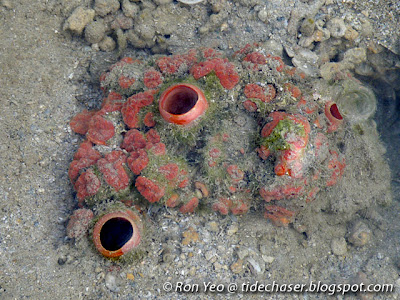
Cliona aff. utricularis is a burrowing sponges which usually bore into calcium carbonate structures, such as coral skeleton or shells, and lives in the cavities created. Since most part of the sponge is hidden within the excavated chambers, only the reddish orange structures (papillae) and a few oscules can be seen. The papillae are usually firm with a velvety surface. Boring sponges can affect the growth of oysters or even kill them, and hence they can be quite a serious problem for oyster farmers.
B) Noodle-like

This Terpios sp. is a bright orange sponge with a noodle-like growth form. The individual "noodle" strand is soft, a little elastic but break easily.
C) Branch-like or leaf-like

Callyspongia samarensis is a green, bluish or dark brown sponge with numerous thin and soft branches less than 0.5cm thick.

Halichondria cartilaginea is a rather huge branching sponge that can reach 50cm or more in length. The branches appear flattened with a groove running along the middle. They are about 0.5cm thick, and grow from a common base. This sponge is usually green in colour, due to a symbiotic alga, Cladophoropsis vaucheriaeformis, living intertwined with the sponge cells and spicules.

Haliclona cymaeformis is another green branching sponge which can form large spreading mats over 0.5m wide. The branches are thick (more than 1cm) and short, and, unlike the previous species, do not grow from a common base. This sponge also has a symbiotic relationship with an alga, Ceratodictyon spongiosum, which in fact form the bulk of the combined structure.

This purple Callyspongia sp. comes with thick branches over 1cm in diameter. The branching occurs in a distinctive dichotomous pattern.

Clathria reinwardti is commonly seen in areas with calm water, especially in man-made lagoons. It is usually bright orange or brownish in colour, with long, thick, knobby and messily arranged branches.
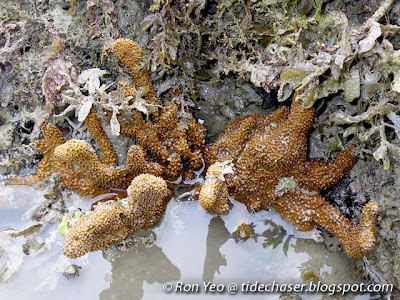
This Ircinia sp. has a spiky surface, and is usually brown or dark brown in colour. The branches are thick, up to a few centimetres across.

Pseudoceratina purpurea can be confused with the previous species, though it is usually yellow, green or olive in colour. The surface is covered in tiny bumps, though a closer look will reveal that the bumps appear more like tiny cones compared to the spiky appearance of the previous species. It can be very variable in its growth form, ranging from encrusting with a few branches, to a sprawling, overlapping tangle more than 1m wide. The branches are usually relatively thick, and can get to more than 2cm across.

Lamellodysidea herbacea has a leafy appearance. It is usually greyish or bluish in colour, with the surface densely marked with tiny bumps. It usually hosts symbiotic blue-green algae (or cyanobacteria), which give the sponge its colour.

Callyspongia diffusa may exhibit a leafy, fan-like appearance, or appears as a clump of short and thick branches. It is usually brown or brownish purple in colour. The surface is rough and bumpy.
D) Chimney-like (interfused tube-like structures with upward-pointing oscules)

This greenish Haliclona sp. is very commonly seen, with slender chimney-like structures about 1-2cm wide and numerous smaller secondary branches.
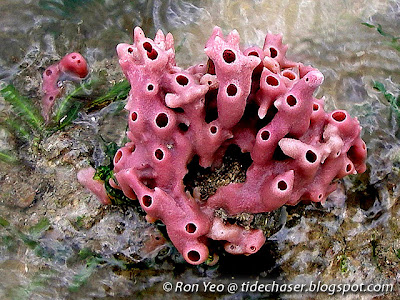
Haliclona cf. baeri is a distinctive sponge with its bright pinkish red coloration. The chimney-like structures are about 2-3cm thick.

This black Haliclona sp. has a bumpy surface with thick tubular structures.
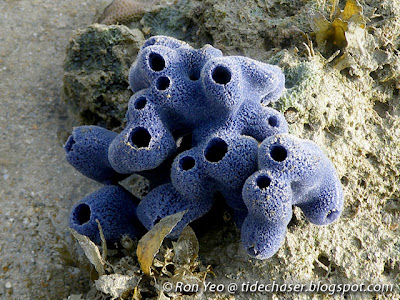
This blue Neopetrosia sp. has a rough and fissured surface, with each of the tubular structures up to about 5cm across. The Funeral Nudibranch (Jorunna funebris) has been observed feeding on this sponge.
E) Pillar or tube-like

Aka aff. maldiviensis usually occurs in the form of either a single white pillar or a clump of several white pillars. This is a boring species, and hence the bulk of the sponge is actually underground, cavities that it has created by boring into calcium carbonate structures such as corals or shells.

Oceanapia sagittaria, sometimes called the Red Maiden's Fan, has a distinctive flower-like structure at the top of the pillar-like structure. The bulk of the sponge is underground in the soft substrate. If broken, the flower-like structure will be swept away by the current to settle and develop into a new sponge on suitable substrates.

Coelocarteria singaporensis, as the name implies, was described from specimens from Singapore. It is usually yellowish or greenish in colour, with numerous pillar-like or tube-like structures, with one or more openings.
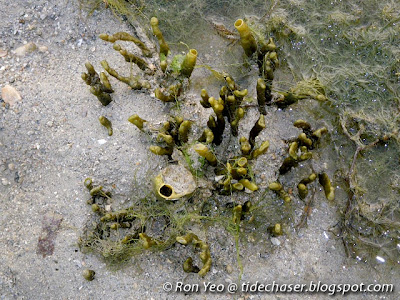
Here is a greenish Coelocarteria singaporensis.

This Spheciospongia sp. is usually yellowish to orangy-brown with cone-like pillars.

This is another Spheciospongia sp. with cone-like pillars extending from a massive structure underneath.

Spheciospongia cf. vagabunda, on the other hand, is dark brown with thick pillars that top off with a blunt tip or a round bud. If broken, the round bud will drift with the currents and eventually settle down to develop into a new sponge on suitable substrates. This species can be very variable though, and cushion-like massive forms can also be found (see below).
F) Massive or cushion-like

This Spheciospongia cf. vagabunda, unlike the ones in the previous photo above, exhibits a massive, cushion-like form.

This black Hippospongia sp. is usually covered with sediment. It has numerous oscules and a generally flattish top. Hippospongia sponges are exploited for making bath sponges, which is prepare by removing all living sponge cells and leaving only the organic collagenous skeleton behind. These natural bath sponges are more resistant to acid, easier to clean, and more durable.

This Spongia sp. is also black in colour, and can be confused with the previous species, except that it has a symbiotic relationship with the Sponge Finger Oyster (Vulsella vulsella), which can be easily seen by the many protruding finger-like structures on the surface. Other Spongia species without the clams are known to exist in Singapore waters, and these "clamless" species can be differentiated from the Hippospongia species by having only a few big oscules compared to the numerous oscules found in the latter. Spongia sponges are also exploited for making into bath sponges.

Dysidea spp. are generally difficult to identify to the species as they do not produce their own spicules, but instead incorporate foreign objects such as sand grains or broken spicules of other species to form their skeletons. The above photo features one that form cushion-like to rounded structures, with a spiny surface. It is usually bluish to purplish in colour, depending on the type of symbiotic bacteria it hosts.
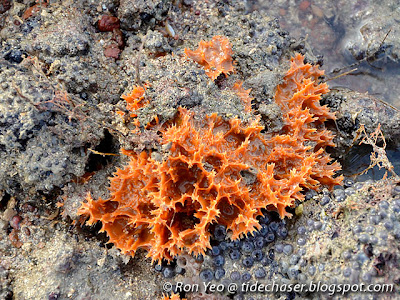
Mycale parishi is a very variable sponge, which can be encrusting, or forming small cushion-like structures, or even branch-like structures. It can, however, be recognised by the spiky appearance and bright orange colour.

Mycale grandis is bright red or orangy-red in colour. It usually starts growing inside cracks and crevices, but eventually becomes a massive cushion-like structure. Numerous oscules over 1cm wide can be seen distributed somewhat evenly over the surface.

The above photo features a massive cushion-like Mycale grandis.
G) Ball-like or pot/vase-like

Cinachyrella australiensis is just one of several rounded, ball-like sponges in local waters, but rather unfortunately, I do not have good photos of the other similar-looking species. It is often covered in sediment trapped by its needle-like spicules. Several yellowish, pore-bearing depressions can usually be seen on the surface. This sponge should never be handled, as the sharp spicules can pierce your skin and get embedded inside, causing a lot of discomfort.

Tethya robusta is another ball-like sponge, but can be differentiated from the others by the many root-like or filament-like extensions. Tiny buds can often be found at the tip of some of these extensions. It comes in a variety of colours, ranging from white to bright yellow and red. They are commonly found under rocks or in crevices.
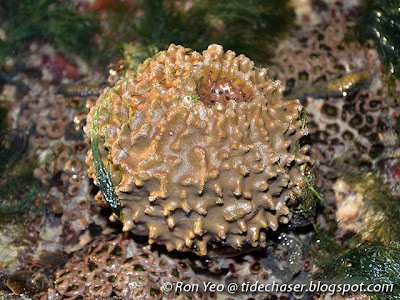
Rhabdastrella globostellata is a somewhat spherical sponge with one or more depressions in the middle. It is usually brown in colour, with numerous irregular ridges on the outer surface. This rather huge sponge can get to more than 30cm across.

Xestospongia testudinaria is another huge sponge with one (and sometimes more) depression in the middle, giving it a barrel-like appearance, and hence it is sometimes called the Barrel Sponge. Unlike the previous species, the depression is much deeper, and can be more than 1 third of the height of the sponge. Young Barrel Sponges are very variable in their shapes, but will usually assume the barrel-shape when they are bigger. They can grow to more than 1m across. Thick ridges can be found on the outer surface, and most of them run along the height of the sponge.

Xestospongia testudinaria is usually reddish brown to pinkish red in colour. The above is a smaller specimen with a less rounded appearance.

Echinodictyum mesenterinum is a vase-like sponge that is more commonly found in deeper waters on reef slopes. It is sometimes seen in shallower waters under jetties.
H) Encrusting

Chondrilla australiensis forms a thin layer over rocks and other hard substrates. It has a smooth and glossy surface, and the colour can be brown, greyish brown or grey. It is sometimes confused with brown-coloured colonial ascidians, but lacks the zooids (individual animals) found on the later.

Lendenfeldia cf. chondrodes is another encrusting sponge, usually greenish to bluish in colour. The surface is smooth and glossy.

This Mycale sp. is also an encrusting species. As there are several encrusting red sponges, they are easily confused with each other. This species has a smooth surface, while others may feel velvety or rough when touched.

This Suberites sp. has very variable forms, from encrusting to somewhat thinly cushion-like with protruding structures. The colour is very variable too, ranging from bright colours such as blue, red and yellow to dull colours such as grey and dirty green.

Some species of Haliclona are also found in encrusting forms, which have a few low chimney-like structures with the oscules.
References
Sponges are essentially a congregation of several types of cells which form an organised structure with numerous pores and channels for the circulation of water - the water usually enters the sponge via the tiny pores, and is excreted via a few bigger mouth-like openings called the oscules.
The cells perform various functions - some may consume the suspended food particles in the water, some may construct the skeleton, while others may be for reproduction purposes. Many of the cells perform more than one function.
Most sponge species have a skeleton made up of tiny structures called spicules, which can come in a wide variety of shapes and sizes - they may appear like rods, stars, needles, balls, and hooks etc. The spicules may also be laced with toxins, and hence it is important not to handle sponges with bare hands. These toxins may protect the sponges from many predators, but there are still many animals, such as turtles, slugs and flatworms, which have adapted to feed on these poisonous sponges.
Sponges are able to reproduce both sexually and asexually. Many of them have separate sexes, while others can alternate between producing either eggs or sperm. Fertilisation can take place externally, when the eggs and sperm are released together into the water. In some cases, they can also take place internally, when the sperm released by the males are captured by the females to fertilise the eggs within them. The eggs will eventually develop into planktonic larvae and leave the female via the exhalant channels and oscules. Asexual reproduction in sponges include: budding, where a sponge split into two sponges or grow a new one out of the main body; and fragmentation, where small pieces break away from the sponge, get carried by the current to another location, and then settle down on suitable substrates to develop into a new sponge.
Some sponges have symbiotic relationship with various species of algae, with the latter living within the sponge structure between the various cells. The algae photosynthesize and provide food for the host sponges in return for shelter and protection. The porous nature of sponges with the numerous pores and channels also provide habitats for smaller invertebrates, such as brittle stars and shrimps. These commensals live within the sponge for protection, and some also depend on the water current generated by the sponges for a supply of suspended food particles.
Sponges also have many interesting uses for human. The most well-known use of sponges will be that they can be made into bath sponges. Compounds with anti-cancer, antiviral, antibacterial and anti-inflammatory properties have also been discovered in different species, making them an important source of raw materials in the biomedical industry.
Identifying sponges to the species level is a very tough process, as it often involves looking at the tiny spicules and internal structures of the sponges. Most of the sponges below were kindly identified by Swee Cheng when he helped conducted a sponge workshop for Project Semakau (Thanks, Swee Cheng). I only have some of the commonly seen sponges here, so for more details do check out Swee Cheng's "A Guide to Sponges of Singapore".
The sponges below are all of the class Demospongiae. This class includes the majority of the sponges, and they can come in very diverse forms, colours and texture. The skeleton can be made up of siliceous spicules and/or fibrous structures, and sometimes there may be no skeleton all together.
Many of the sponge families are distinguished by their internal structures, and since it will be quite impossible to examine the spicules carefully in the field to identify them, I have decided to group my photos below by their appearances instead of their families.
- Dense round patches on the substrate with a few big openings (oscules)
- Noodle-like
- Branch-like or leaf-like
- Chimney-like (i.e. interfused tube-like structures with upward-pointing oscules)
- Pillar or tube-like
- Massive or cushion-like
- Ball-like or pot/vase-like
- Encrusting
A) Dense round patches on the substrate with a few big openings (oscules)

Cliona aff. utricularis is a burrowing sponges which usually bore into calcium carbonate structures, such as coral skeleton or shells, and lives in the cavities created. Since most part of the sponge is hidden within the excavated chambers, only the reddish orange structures (papillae) and a few oscules can be seen. The papillae are usually firm with a velvety surface. Boring sponges can affect the growth of oysters or even kill them, and hence they can be quite a serious problem for oyster farmers.
B) Noodle-like

This Terpios sp. is a bright orange sponge with a noodle-like growth form. The individual "noodle" strand is soft, a little elastic but break easily.
C) Branch-like or leaf-like

Callyspongia samarensis is a green, bluish or dark brown sponge with numerous thin and soft branches less than 0.5cm thick.

Halichondria cartilaginea is a rather huge branching sponge that can reach 50cm or more in length. The branches appear flattened with a groove running along the middle. They are about 0.5cm thick, and grow from a common base. This sponge is usually green in colour, due to a symbiotic alga, Cladophoropsis vaucheriaeformis, living intertwined with the sponge cells and spicules.

Haliclona cymaeformis is another green branching sponge which can form large spreading mats over 0.5m wide. The branches are thick (more than 1cm) and short, and, unlike the previous species, do not grow from a common base. This sponge also has a symbiotic relationship with an alga, Ceratodictyon spongiosum, which in fact form the bulk of the combined structure.

This purple Callyspongia sp. comes with thick branches over 1cm in diameter. The branching occurs in a distinctive dichotomous pattern.

Clathria reinwardti is commonly seen in areas with calm water, especially in man-made lagoons. It is usually bright orange or brownish in colour, with long, thick, knobby and messily arranged branches.

This Ircinia sp. has a spiky surface, and is usually brown or dark brown in colour. The branches are thick, up to a few centimetres across.

Pseudoceratina purpurea can be confused with the previous species, though it is usually yellow, green or olive in colour. The surface is covered in tiny bumps, though a closer look will reveal that the bumps appear more like tiny cones compared to the spiky appearance of the previous species. It can be very variable in its growth form, ranging from encrusting with a few branches, to a sprawling, overlapping tangle more than 1m wide. The branches are usually relatively thick, and can get to more than 2cm across.

Lamellodysidea herbacea has a leafy appearance. It is usually greyish or bluish in colour, with the surface densely marked with tiny bumps. It usually hosts symbiotic blue-green algae (or cyanobacteria), which give the sponge its colour.

Callyspongia diffusa may exhibit a leafy, fan-like appearance, or appears as a clump of short and thick branches. It is usually brown or brownish purple in colour. The surface is rough and bumpy.
D) Chimney-like (interfused tube-like structures with upward-pointing oscules)

This greenish Haliclona sp. is very commonly seen, with slender chimney-like structures about 1-2cm wide and numerous smaller secondary branches.

Haliclona cf. baeri is a distinctive sponge with its bright pinkish red coloration. The chimney-like structures are about 2-3cm thick.

This black Haliclona sp. has a bumpy surface with thick tubular structures.

This blue Neopetrosia sp. has a rough and fissured surface, with each of the tubular structures up to about 5cm across. The Funeral Nudibranch (Jorunna funebris) has been observed feeding on this sponge.
E) Pillar or tube-like

Aka aff. maldiviensis usually occurs in the form of either a single white pillar or a clump of several white pillars. This is a boring species, and hence the bulk of the sponge is actually underground, cavities that it has created by boring into calcium carbonate structures such as corals or shells.

Oceanapia sagittaria, sometimes called the Red Maiden's Fan, has a distinctive flower-like structure at the top of the pillar-like structure. The bulk of the sponge is underground in the soft substrate. If broken, the flower-like structure will be swept away by the current to settle and develop into a new sponge on suitable substrates.

Coelocarteria singaporensis, as the name implies, was described from specimens from Singapore. It is usually yellowish or greenish in colour, with numerous pillar-like or tube-like structures, with one or more openings.

Here is a greenish Coelocarteria singaporensis.

This Spheciospongia sp. is usually yellowish to orangy-brown with cone-like pillars.

This is another Spheciospongia sp. with cone-like pillars extending from a massive structure underneath.

Spheciospongia cf. vagabunda, on the other hand, is dark brown with thick pillars that top off with a blunt tip or a round bud. If broken, the round bud will drift with the currents and eventually settle down to develop into a new sponge on suitable substrates. This species can be very variable though, and cushion-like massive forms can also be found (see below).
F) Massive or cushion-like

This Spheciospongia cf. vagabunda, unlike the ones in the previous photo above, exhibits a massive, cushion-like form.

This black Hippospongia sp. is usually covered with sediment. It has numerous oscules and a generally flattish top. Hippospongia sponges are exploited for making bath sponges, which is prepare by removing all living sponge cells and leaving only the organic collagenous skeleton behind. These natural bath sponges are more resistant to acid, easier to clean, and more durable.

This Spongia sp. is also black in colour, and can be confused with the previous species, except that it has a symbiotic relationship with the Sponge Finger Oyster (Vulsella vulsella), which can be easily seen by the many protruding finger-like structures on the surface. Other Spongia species without the clams are known to exist in Singapore waters, and these "clamless" species can be differentiated from the Hippospongia species by having only a few big oscules compared to the numerous oscules found in the latter. Spongia sponges are also exploited for making into bath sponges.

Dysidea spp. are generally difficult to identify to the species as they do not produce their own spicules, but instead incorporate foreign objects such as sand grains or broken spicules of other species to form their skeletons. The above photo features one that form cushion-like to rounded structures, with a spiny surface. It is usually bluish to purplish in colour, depending on the type of symbiotic bacteria it hosts.

Mycale parishi is a very variable sponge, which can be encrusting, or forming small cushion-like structures, or even branch-like structures. It can, however, be recognised by the spiky appearance and bright orange colour.

Mycale grandis is bright red or orangy-red in colour. It usually starts growing inside cracks and crevices, but eventually becomes a massive cushion-like structure. Numerous oscules over 1cm wide can be seen distributed somewhat evenly over the surface.

The above photo features a massive cushion-like Mycale grandis.
G) Ball-like or pot/vase-like

Cinachyrella australiensis is just one of several rounded, ball-like sponges in local waters, but rather unfortunately, I do not have good photos of the other similar-looking species. It is often covered in sediment trapped by its needle-like spicules. Several yellowish, pore-bearing depressions can usually be seen on the surface. This sponge should never be handled, as the sharp spicules can pierce your skin and get embedded inside, causing a lot of discomfort.

Tethya robusta is another ball-like sponge, but can be differentiated from the others by the many root-like or filament-like extensions. Tiny buds can often be found at the tip of some of these extensions. It comes in a variety of colours, ranging from white to bright yellow and red. They are commonly found under rocks or in crevices.

Rhabdastrella globostellata is a somewhat spherical sponge with one or more depressions in the middle. It is usually brown in colour, with numerous irregular ridges on the outer surface. This rather huge sponge can get to more than 30cm across.

Xestospongia testudinaria is another huge sponge with one (and sometimes more) depression in the middle, giving it a barrel-like appearance, and hence it is sometimes called the Barrel Sponge. Unlike the previous species, the depression is much deeper, and can be more than 1 third of the height of the sponge. Young Barrel Sponges are very variable in their shapes, but will usually assume the barrel-shape when they are bigger. They can grow to more than 1m across. Thick ridges can be found on the outer surface, and most of them run along the height of the sponge.

Xestospongia testudinaria is usually reddish brown to pinkish red in colour. The above is a smaller specimen with a less rounded appearance.

Echinodictyum mesenterinum is a vase-like sponge that is more commonly found in deeper waters on reef slopes. It is sometimes seen in shallower waters under jetties.
H) Encrusting

Chondrilla australiensis forms a thin layer over rocks and other hard substrates. It has a smooth and glossy surface, and the colour can be brown, greyish brown or grey. It is sometimes confused with brown-coloured colonial ascidians, but lacks the zooids (individual animals) found on the later.

Lendenfeldia cf. chondrodes is another encrusting sponge, usually greenish to bluish in colour. The surface is smooth and glossy.

This Mycale sp. is also an encrusting species. As there are several encrusting red sponges, they are easily confused with each other. This species has a smooth surface, while others may feel velvety or rough when touched.

This Suberites sp. has very variable forms, from encrusting to somewhat thinly cushion-like with protruding structures. The colour is very variable too, ranging from bright colours such as blue, red and yellow to dull colours such as grey and dirty green.

Some species of Haliclona are also found in encrusting forms, which have a few low chimney-like structures with the oscules.
References
- Lim, S. C., N. J. De Voogd & K. S. Tan. 2008. A Guide to Sponges of Singapore. Singapore Science Centre, Singapore. 173 pp.
- Ruppert, E. E. & R. D. Barnes. 1991. Invertebrate Zoology (International Edition). Saunders College Publishing. U.S.A. 1056 pp.
- Tan, L. W. H. & P. K. L. Ng. 1988. A Guide to Seashore Life. Singapore Science Centre. Singapore. 160 pp.
- World Register of Marine Species. 2012. Retrieved Feb 25, 2013, from http://www.marinespecies.org.

2 comments:
Really lovely! Amazing diversity shown here, and the photos are spectacular. I appreciate the amount of work that goes into collecting all those images. Wow.
Hi! I am Dr. Swapnaja from India. Working on sponges here and found your blog quite informative. Thanks.
contact: sa_mohite@yahoo.co.in
Post a Comment